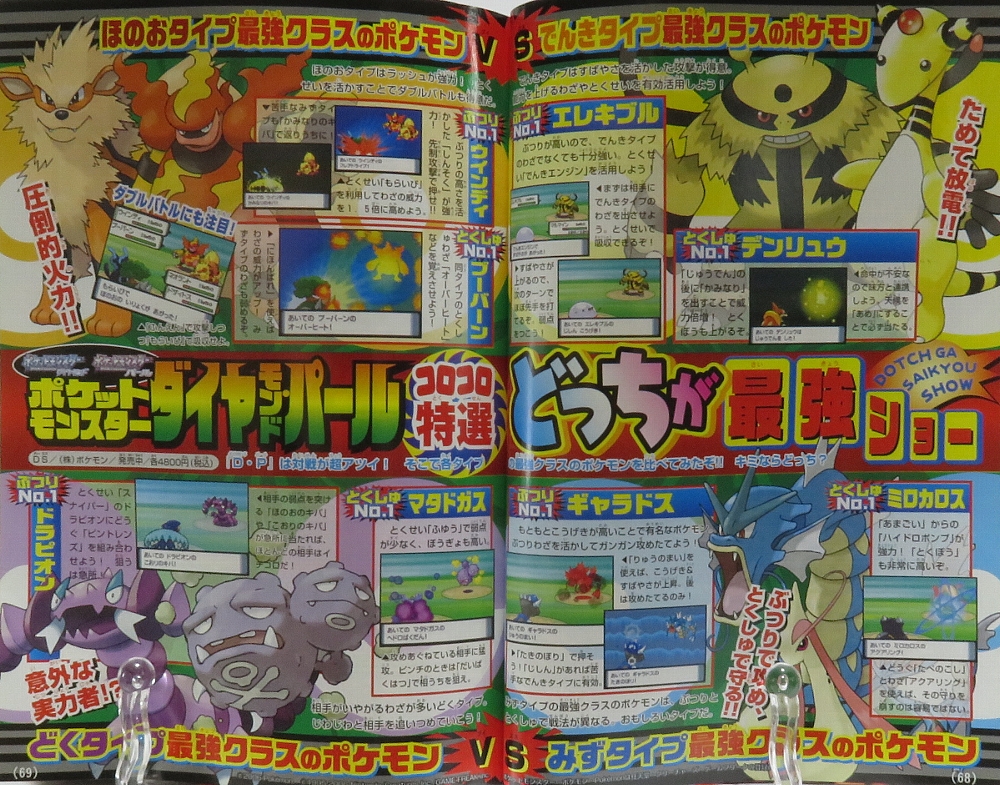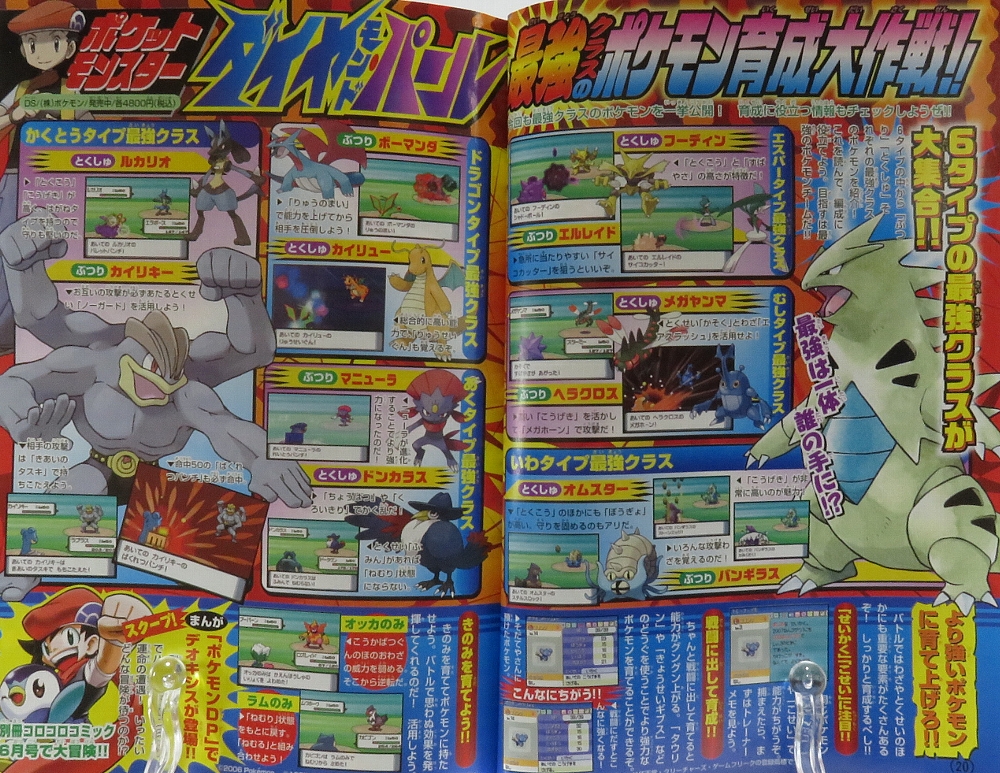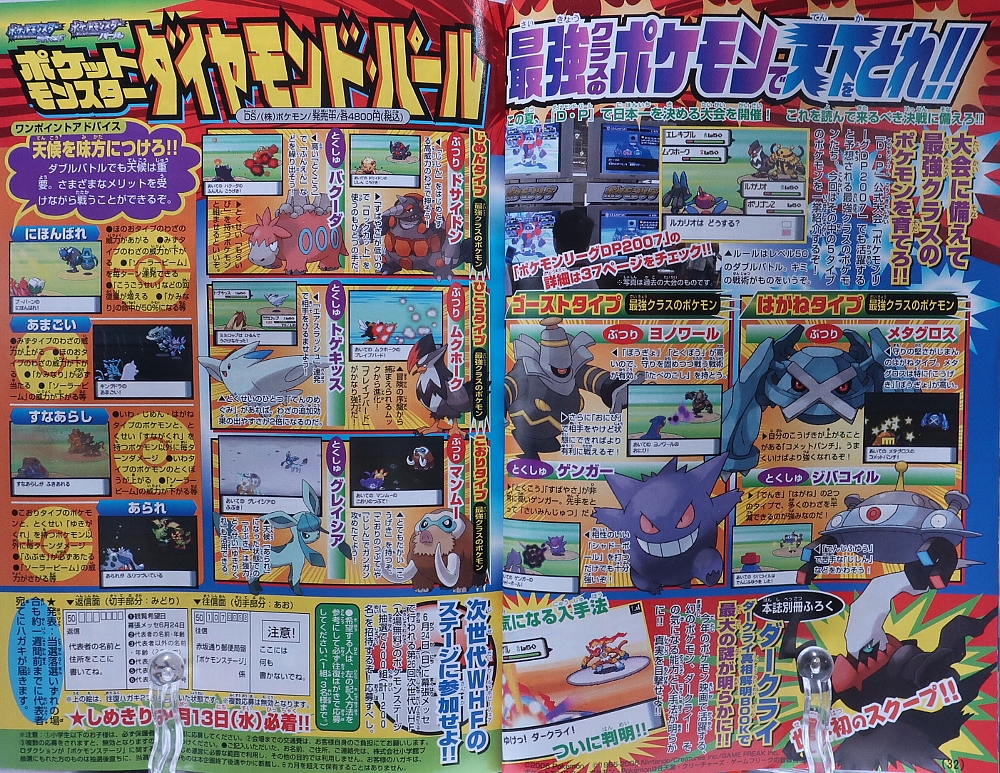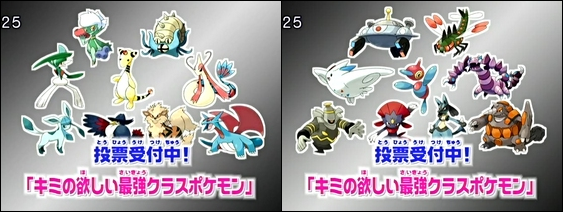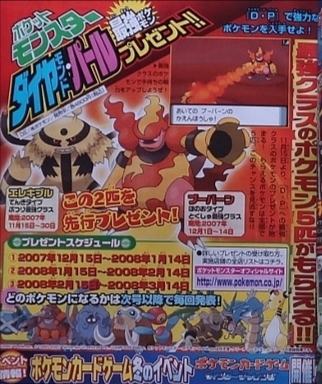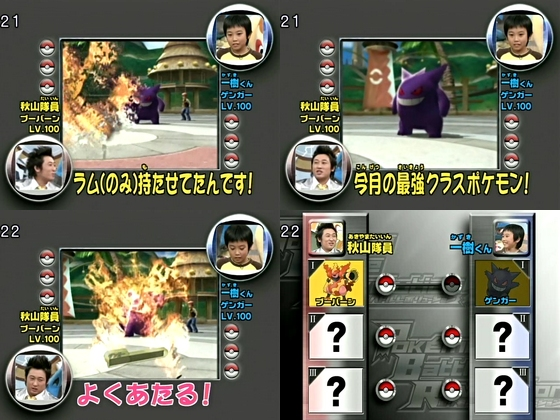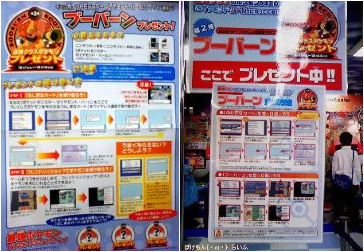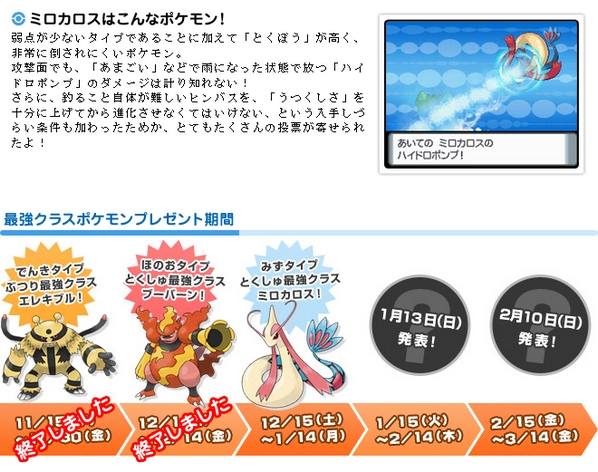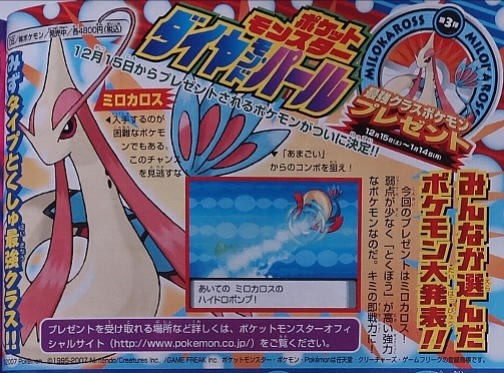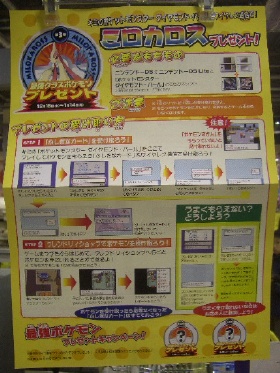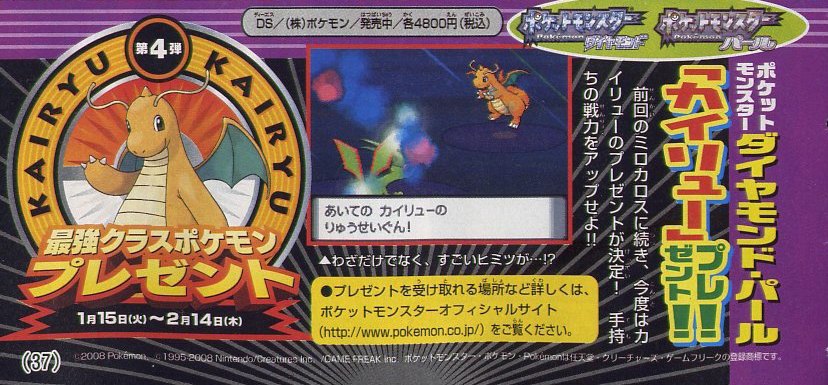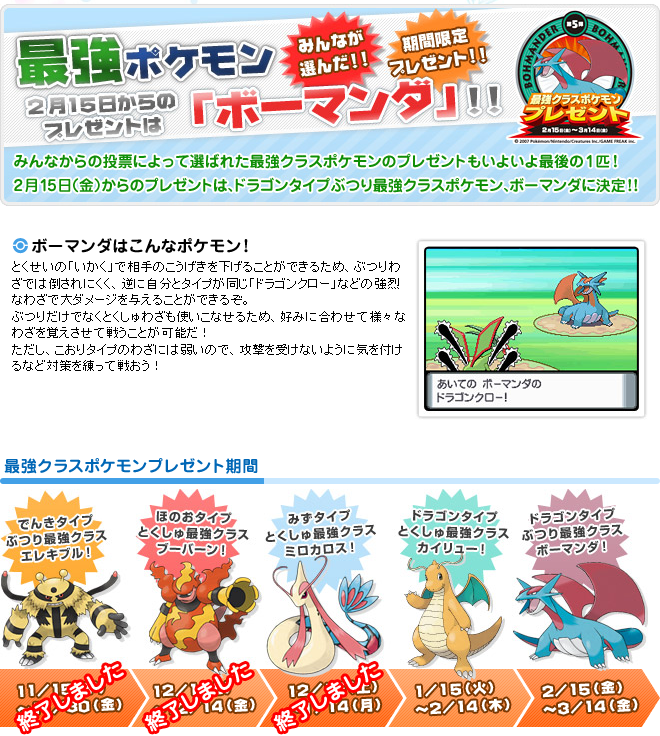“Strong Pokémon. Weak Pokémon. That is only the selfish perception of people. Truly skilled trainers should try to win with their favorites.”
Regardless… It can’t hurt to bend the odds in your favour a little, can it? By fielding one or more of Japan’s five Saikyou “Strongest Class” Pokémon, for instance, given out as in-life events for Pokémon Diamond & Pearl.
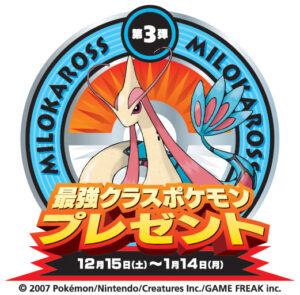 The distribution of “Strongest” Electivire, Magmortar, Milotic, Dragonite, and Salamence was by no means an isolated incident. You see, the arrival of Generation Sinnoh‘s Global WiFi capabilities meant that Pokémon acquired a truly global dimension, in turn allowing for the maturation of an (inter)national competitive element alongside the franchise’s long-standing bread and butter of collecting pocketmonsters for its own sake. “Strongest” became a prominent theme in the Japanese world of Pokémon throughout 2007 and into 2008. The distribution of the Saikyou Five must be seen in this light, that is, as part of a promotional thrust to nurture a culture of WiFi battling and draw players into a rapidly expanding competitive scene.
The distribution of “Strongest” Electivire, Magmortar, Milotic, Dragonite, and Salamence was by no means an isolated incident. You see, the arrival of Generation Sinnoh‘s Global WiFi capabilities meant that Pokémon acquired a truly global dimension, in turn allowing for the maturation of an (inter)national competitive element alongside the franchise’s long-standing bread and butter of collecting pocketmonsters for its own sake. “Strongest” became a prominent theme in the Japanese world of Pokémon throughout 2007 and into 2008. The distribution of the Saikyou Five must be seen in this light, that is, as part of a promotional thrust to nurture a culture of WiFi battling and draw players into a rapidly expanding competitive scene.
But, we are getting ahead of ourselves. How did the powers that be land on these five Pokémon specifically? How did players feel about them? And how exactly did the digital distribution fit in with 2007’s broad-based “Strongest” campaign? Well, you’re about to find out. This is the story of the Saikyous.
Strong. Stronger. Strongest.
September 2, 2007, Osaka, Japan. Microphone in hand and flanked by contestants from the junior and senior divisions, GameFreak’s Junichi Masuda addresses the crowd. The livestage battle tournaments at Pokémon’s cross-country “PalCity” Festa have been a success, culminating in the coronation of Generation Sinnoh’s first two national champion Trainers.
Upon returning home, Masuda sits down behind his laptop, and lays out the ambitions for Pokémon’s competitive scene on his personal blog: first, a proper all-Japan Championship, then, with the infrastructure in place, a ground-breaking World’s Championship, featuring competitors from every corner of the planet. Within a year, a “Showdown” VGC is held in Orlando, Florida, the road paved for an evolving hierarchy of regional, national and international tournaments stretching out towards the present.
Watershed moments in the franchise are many. The debut of Red & Green in 1996. Kalos’ transition to 3D. The embrace of open-world gameplay with Legends: Arceus. PalCity was one such pivotal moment, a snapshot of greater and grander things to come. The opportunities afforded by local and global WiFi lent competitive Pokémon fresh impulse as, released from the bounds of proximity and the constraints of link cables, players could now battle one another freely over the airwaves, seeking out opponents worldwide anywhere, at any time.
But. How to reorient the ginormous playerbase’s interest, so long firmly fixated on the collectathon dimension to Pokémon, towards high-powered competitive battling? How to nudge them to explore the limitless possibilities of spontaneous showdowns? Towards the intricacies of team-building, singles and doubles strategies, good picks, mediocre picks, and bad picks? It must’ve been quite the conundrum.
Whatever the exact solution, a 12-month long cross-media “Saikyou” campaign designed to familiarise players with qualities of Pokémon expertly suited for battle was clearly intended to form part of the answer. This de facto crash course in the cream of the crop of all 491 pocketmonsters had three prongs: promotion in CoroCoro Monthly, attention in variety tv-show Pokémon Sunday, and finally once the seeds had been planted, a Pokémon distribution for Diamond & Pearl. Let’s take a look.
CoroCoro Leads the Charge
The close partnership between Japan’s premier animanga magazine, CoroCoro Monthly, and the Pokémon franchise needs little introduction. Concern it news, promotions, or general coverage, CoroCoro was – and is – often Pokémon’s (exclusive) medium of choice. Little wonder, then, that the Saikyou campaign also kicked off in CoroCoro. Readers that pulled the mag’s April 2007’s issue off the shelves discovered on p.68-71 a new feature called “CoroCoro Special Selection” (コロコロ特選). For three straight months, this item measured up the franchise’s “Strongest” Pokémon, weighing key strengths and evaluating stats, movesets and typings of such powerhouses as Tyranitar, Gyarados, Gengar and Dragonite, all in jam-packed colourful two-page spreads that directed the eye every which way. I could explain more, but it’s probably easier to just show you.
Wowza. Splashy and colourful, quintessentially CoroCoro! I want to draw attention to a few things about this three-issue “Saikyou Show”. First, the amount of print space allocated to it is absolutely remarkable. Why so? Mind you, Spring 2007 was very much the season of freshly-announced Sinnoh Mythical Darkrai, with its Movie 10 promotional train steaming ahead at full clip (see also HERE). Cover after cover of CoroCoro Monthly featured the Phantom Pokémon. Yet despite this, the April issue still set aside a double two-page spread to discuss and debate the Strongest Pokémon. And testimony to how seriously GameFreak took its battle revolution, the May and June CoroCoro issues again included two-page Saikyou spreads, even as July crept closer. (M10 came out that month.) Incidentally, perhaps this surplus of Pokémon promotion is the reason why CoroCoro put out supplementary “Darkrai books” to go with its April and June issues – there simply was not enough space in the main mag’s pages to do all the Pokémon content justice!
Second, pay attention to CoroCoro’s presentation of Strongest Pokémon pairings. Coated in a “versus” format of sorts, intra-type matchups pitted special attackers (とくしゅ) against physical attackers (ぶつり). In full, per issue:
April 2007:
Fire – Arcanine v Magmortar
Electric – Electivire v Ampharos
Poison – Drapion v Weezing
Water – Gyarados v Milotic
Normal – PorygonZ v Slaking
Grass – Tangrowth v Roserade
May 2007:
Fighting – Lucario v Machamp
Dark – Weavile v Honchkrow
Dragon – Dragonite v Salamence
Psychic – Alakazam v Gallade
Bug – Yanmega v Heracross
Rock – Omastar v Tyranitar
June 2007:
Ghost – Gengar v Dusclops
Steel – Metagross v Magnezone
Flying – Staravia v Togekiss
Ice – Glaceon v Mamoswine
Ground – Camerupt v Rhyperior
Obviously, some are uncomfortable fits. Take Salamence, for instance, who got billed as a physical attacker when it can competently run mixed sets. But, as we will see, precise categorisation was not the point. Rather, it was inclusion that counted, for that made the Pokémon eligible for attention and discussion in CoroCoro and Pokémon Sunday and, later on, a shot at being picked for distribution in Diamond & Pearl. Because, if it wasn’t obvious already, this 34-Pokemon selection across 17 typings was set in stone for the duration of the Saikyou campaign, and we will notice the exact same pairings reappear on Sunday and in the – spoilers! – digital poll that followed later.
Third, I was initially left wondering whether CoroCoro organised a reader “Strongest” poll of some kind. The mag’s headline Kanji “特選” can be read two ways, taken to mean special selection or special election.1In full: 「ポケモンダイヤモンド・パールコロコロ特選どっちが最強ショー」 Knowing what came after in the digital realm, I at first intuitively assumed that CoroCoro, too, held a reader vote to pick the audience’s favourite Strongest Pokémon from among the 34. By mail-in postcard, for example, with rankings and results published in a Summer issue. However, if there was indeed a CoroCoro vote, and if rankings were indeed compiled, I’ve been unable to find any evidence of it in the – admittedly limited – scans and visual material available to me. And not on the archived CoroCoro website, either (corocoro.tv). Simply put, the sole purpose of CoroCoro’s curated Pokémon picks was to underscore D&P’s powerful offerings and rouse reader interest in competitive battling. Informational and motivational only.
Pokémon Sunday Doubles Down
Onto Sunday! Here, too, the Strongest Pokémon and their battle prowess were promoted. Now, Sunday included a “Battle Corner” as part of its standard programming during the Sinnoh era. Almost every episode, a member of Sunday’s cast – Shokotan, Golgo, or one of Robert’s crew – would take on a guest in a televised D&P singles or doubles battle, usually an invitee schoolkid, or on occasion a celebrity with a special love for Pokémon. This segment was commonly an episode’s final one before the outro rolled.
For at least 8 straight episodes spanning #136 (May 20, 2007) through #143 (July 8, 2007), Sunday appended what one blogger and viewer dubbed a “Strongest Pokémon Corner”2Words of blogger “Sagittarious” to the battle section of every show. Much like CoroCoro had done in print, the segment contrasted two Pokémon of a specific type – Gyarados v Milotic, Gallade v Alakazam, and so on – and debated their respective virtues and weaknesses. The timing of it all was conspicuous, coinciding with the run-up to Summer 2007’s PalCity where, as we’ve seen, Pokemon’s newfound battle dimension loomed large. I sadly don’t have access to footage of the show, so I can only make an educated guess how the commentary was styled. But we may infer that again like CoroCoro, it encompassed notes on battle aptitude, talents, movesets, and strategies of Strongest Pokémon to get the most battle mileage out of them. Furthermore, I can’t say with certainty that all 17 type pairings were covered, but at minimum were featured, in order of appearance: Water, Electric, Fire, Fighting, Flying, Ground, and Psychic.

Gyarados and Milotic compared and contrasted. Stills from: Pokémon Sunday #136, via pocketmonsters.net
In terms of the digital distribution that followed in late 2007, Sunday paid attention to that too. Sunday #156 (October 7, 2007) shared news of the upcoming “Gift Campaign” and urged viewers to make their voices heard and support their favourite Pokémon. So far, so unsurprising, right? It is puzzling, however, that none of the three popular-vote winners seem to have been promoted individually on Sunday. In other words, none of that “get your Milotic, Dragonite and Salamence now at PokeCenters and participating stores” as would be the case for, say, Nuketta Wobbuffet on Pokémon Get☆TV some years later. Although – in a final caveat – it is quite possible that a line to that effect was dropped on Sunday #164 (December 2, 2007), when Robert’s Ryuuki Akiyama demonstrated the powers of Saikyou Magmortar by fielding it as his lead in a 3v3 televised Singles Battle against a guest. Or perhaps three episodes before that, on Sunday #161 (November 11, 2007), when Robert’s Hiroyuki Baba similarly fielded what looks to have been a Saikyou Electivire. But more on that shortly.
Alright. Considering all the above, it’s plain to see how Saikyou in CoroCoro and Sunday were two expressions of the same campaign. Tangentially, it’s fun to speculate when and where the idea to promote digital battle championships via strong Pokémon found its genesis. My sense is that plans to this effect were drawn up in GameFreak’s offices while the D&P battle system and WiFi capabilities were still in development in 2006. But nevermind that. Following the wrapping up of PalCity in early September 2007, the grand plan’s third leg was about to be put into action. That is, the placing of five Saikyous, two of which pre-selected and three of which elected, in the hands of players so that they might experiment, strategise and triumph with some of the strongest, tailor-made battle-ready monsters to grace the franchise.
Leg Three: Digital Distribution
On October 5, 2007, French fansite PokeBip published a newspost with a title to turn many a Pokefan’s head. “Enorme Distribution de Pokémon au Japon”, it read, or Gigantic Pokémon Distribution in Japan. Something was afoot on the far side of the Pokéworld. And sure enough, those who browsed pokemon.co.jp there discovered a fancy new page with a headline that screamed: “The most powerful Pokémon are coming to your Diamond & Pearl!”.3最強ポケモンがキミの 「ダイヤモンド・パール」にやってくる!! Below it, an explanatory paragraph read, translated:
“Starting Saturday, December 15 [2007], we’ll be giving away Pokémon of the Strongest Class for Pokémon Diamond and Pearl! Among them, three will be decided by popular vote. Choose the Pokémon you want, then click the button below to go to the voting page! Vote for the Pokémon you want the most! We’ll announce the details on how and where to pick up your Pokémon on this website in early November, so be sure to check back!”4「12月15日(土)より、「ポケットモンスターダイヤモンド・パール」への 最強クラスポケモンのプレゼントを実施するよ!! しかもプレゼントされるのは、最強クラスポケモンの中から、みんなからの 投票で選ばれた3匹!さあ、ほしいポケモンを選んだら、下のボタンから 投票ページへ!一番ほしいポケモンに投票しよう!くわしい受け取り方法や受け取り場所は、 「11月上旬このホームページで発表するから、しっかりチェックしておいてね!」
Below that, in turn, were shown two columns with pictures of votable Pokémon. As you will understand, these comprised the 34 usual suspects categorised into 17 types and split by special versus physical attackers. Well, 32 total Pokémon, not 34, to be precise. Two had been set apart from the available selection, to wit Magmortar and Electivire. The reason: their (re)distribution had already been predetermined by the higher powers. Specifically, Winter 2006/07 “Battle Festa” MagBuzz were to be dusted off, given a fresh paint job, evolved and recycled as Saikyous with a new OTN/TID combination and upgraded movesets and traits. I don’t know why GameFreak went this route beyond the official website’s explanation that Festa MagBuzz had been “extremely well-received”, which was apparently cause to give out the same thing again. A wiser approach would have had players elect all five Saikyou, but alas. On that note, in case it wasn’t already apparent, I want to emphasise that not all 34 candidate Saikyou Pokémon would be distributed, as PokeBip had initially erroneously assumed. I also want to point out once more that the vote did not constitute a series of head-to-heads by typing as the pairings might at first glance suggest. Rather, it was a free-for-all, each Pokéfan getting to cast a single ballot.
A link in the official article led to a businesslike vote page (here), marked by row upon row of checkboxes. A notification warned fans that multiple vote submissions would be declared invalid. The basic simplicity of this polling page belied its historic character: only for the second time was voting power handed to the players, after the 10th Anniversary M10 preorder bonus a few months earlier that had resulted in the distribution of 10th Deoxys. Quite understandably, the prospect of a player vote invited considerable enthusiasm. Everybody had a favourite. Blogger “sagittarious” repeatedly hoped for Weezing. Others, like “mew1216” (here), simply held the opinion that all 34 should be distributed.5「個人的には全部配布してほしかったです」 On October 31, 2007 at 5PM JST, some three weeks after the original announcement, polls finally closed. And thus began the waiting game to learn the three winners piecemeal, one by one, as they were rolled out. Incidentally, to my knowledge, the final, full vote count and/or share were never made public.
So! With all that ground covered, let’s take a look at the Saikyou themselves and their reception by players. Starting with, first, that shoehorned-in distribution, the reskinned Electabuzz.
Strongest Class Pokémon #1: Electivire
As the first of five of Saikyou, Electivire established the distribution pattern for the entire series. Which is to say, players enjoyed broad availability of the Pokémon not just from PokeCenters but, much like 10th Deoxys and Golgo Octillery, also from a range of (toy)stores that included JUSCO, Aeon, Ito-Yokado and Toys R Us. In terms of information, Electivire was given the standard treatment with its very own instructional distribution poster as well as window ads at PokeCenters. As mentioned before, Electivire was available between November 15-30, 2007 – or meant to be, anyway.
CoroCoro and Sunday were once again at the forefront of Saikyou promotion. For one, CoroCoro’s December 2007 issue (on shelves November 15, 2007, coinciding with Electivire’s release) set aside half a page to spread the word of Strongest E-Vire and Magmortar. The red on red sure made for a fiery look! Naturally, CoroCoro did not neglect to tease the reveal of Saikyou #3, and encouraged readers to pick up the next issue in four weeks’ time (January 2008) and find out.6「どのポケモンになるかは次号以で降每回発表」 As for Sunday, Baba employed Saikyou Electivire in a Singles Battle on Sunday #161 (November 11, 2007). And although Baba triumphed over his opponent, an elementary schooler with a team of Pidgeot, Blaziken and Torterra, he did not find much success with Electivire as it falled to put a meaningful dent in the opposing team and ultimately fell to Torterra shortly after striking it with Fire Punch. But no matter – for the purposes of promotion, what counted was E-Vire’s airtime.
Now, player experiences with Saikyou Electivire are fairly well-documented. Which is to say, available to us are numerous first-hand accounts of fans’ collecting theirs at participating retailers and recording their thoughts on the desirability and usefulness of the Pokémon. Two themes emerge. First, as so often, the stories speak of pros and cons to the expansion of distribution tech to third-party shops and their apparent wavering dedication in making the event a success. Second, players questioned the design, utility and credentials of E-Vire (and Magmortar) as “Strongest”. Let’s take a look at some accounts.
Starting with blogger “hamariya” (here), whose observations are worth quoting in full. Translated, they read:
“I had passed up the previous [Battle Festa MagBuzz, ed.] distribution because it relied on double-slot use, but this time I went to the nearest JUSCO after hearing that it would be distributed wirelessly. It was a weekday evening, so there were few people there. The poster announcing the distribution was in front of the cash register, so I felt uncomfortable opening my DS there. Hiding behind the shelves of merchandise, I picked up a wireless signal! In an instant, Electivire arrived. Long live wireless! The times have evolved, haven’t they, to be able to obtain them [Pokémon] so easily. It’s a big help for us just to not have to say to the clerk, “I want a Pokemon…” I wonder if they are converting equipment used in movie theaters. It looks like it will be active in the future.”7「前回の配布はダブルスロット利用によるもの*1だったので見送っていましたが、今回はワイヤレスでの配布と聞いて最寄のジャスコへ行ってきました。平日の夜だったので人は少なし。配布告知ポスターはレジの前だったので、さすがにそこでDSを開くのは気が引ける。商品棚の影に隠れつつ、ワイヤレス受信!一瞬でエレキブルキター。ワイヤレス万歳!こんなに簡単に入手できるとは、時代も進化したものよのう。店員さんに「ポケモン欲しいんですが・・・」って言わなくて済むだけでこちらとしては大助かりですよ。映画館で使った機材を転用してるのかな?今後も活躍しそうですね。」
Wow! Lots to unpack here. First of all, Winter 2006’s Festa Magmortar and Electivire had indeed been available exclusively through the time-worn method of slot-2 distribution, whereby an aide took a player’s Nintendo DS, inserted a distribution ROM cartridge into the device’s GBA slot, and then manually triggered a Pokémon upload. You can also read about it in the context of WHF Manaphy.
By the time of the Saikyou, a year on, this modus operandi was a thing of the past. As you will recall from our article on Movie 10 Darkrai, the arrival of wireless distro tech had been hailed with considerable fanfare. A fully-fledged press conference at a fancy hotel served to impress the who’s who of Japan’s (gaming) media as they got to watch wireless distribution tech in action, first witnessing Pokémon Sunday‘s Shokotan wirelessly download world’s first Eigakan Darkrai to Diamond & Pearl before getting to play with the software themselves. There was even a Darkrai-themed TV commercial to flaunt the technology! Like in America with its raft of Toys R Us events (here), fans quickly embraced wireless Pokémon distributions as the new (and improved) normal, all technical growing pains definitively overcome with February 2007’s Shokotan Tropius and March 2007’s Yamamoto’s Whiscash.8Hamariya’s suggestion that Nintendo DS’s deployed at movie theaters to distribute Darkrai had now been pressed into service at participating stores to facilitate the Saikyou distribution was, in fact, entirely reasonable.
Well, I say that… The experiences of “ryublog0718” and “sagittarious”, on the other hand, suggest hiccups at participating third-party retailers. Although not necessarily representative of the way these stores’ handled the distribution of Electivire, both bloggers’ anecdotes are fascinating regardless. Wrote ryublog0718 on November 28, 2007:
“I’ve been told that the “Strongest Electivire” is being distributed at Pokémon Centers and other stores around the country through this month. I went to the nearest store9Ryublog uses the term “Pokemon Center Satellite” presumably to refer to participating retailers. to pick one up. […] In this cold weather, I blasted off about an hour each way! (By bicycle.) I finally arrived at the store and I looked for the Electivire distribution section and found a poster that looked like it! I turned on my DS and rushed over to the spot, only to find another sign. “Electivire can no longer be distributed.” […] I was in a state of despair… […] But since the situation will not change even if I complain alone I went home before dark. (By bicycle.) I am a little worried that they will [not] distribute the rest of the Pokémon properly.”

Instructional poster and PokeCenter window ad. Image credit: Pikachuftt (left) and frio84 (right)
Man! Gotta feel for the kid. What’s odd about this – November 28 was comfortably inside of Electivire’s official distribution window, which ran through November 30. Blogger “sagittarious”, by contrast, was able to secure an E-Vire just fine, but came away puzzled by poor signposting – a sentiment we also encountered time and again in America’s TRU distributions. They wrote:
“Is it normal to go to a store and not see anything about distribution anywhere? There was no mention of it… I turned on my DS near the game section at random and it was like “I found a Mystery Gift”. Does wireless reach people pretty far away?”
Well, Sagi! Theoretically, there ought to have been a wireless distribution poster positioned somewhere in the shop. Probably. Don’t worry, your fellow blogger “goantokuinn” couldn’t locate it either.10“This morning [November 17], I was able to get the ‘Saikyou Electivire’ that I wrote about yesterday at the nearest store. […] I arrived at the nearest store where they were being distributed. It is a large store, so I really got lost. I think I looked for about 5 mminutes… Finally, I found it. This time, instead of inserting it into the GBA, the system allows you to receive it via wireless communication.” At: http://goanntokuinn.blog120.fc2.com/blog-entry-171.html In any case, let’s shift gears and consider players’ judgement of the Pokémon itself, Strongest Electivire.
To understand some of the criticisms levelled against it, let’s size up the event Pokémon’s competitiveness. Its nature was Serious – odd, to say the least, for a physical attacker. (Why not Adamant?) It held an utterly useless Magnet. And here’s the kicker: Its moveset was Light Screen / Thunder Punch / Discharge / Thunderbolt.

Image credit: mew1216
Players were positively dumbfounded. The triple Electric attack made for major redundancy, with Thunderbolt and Discharge – special attacks no less on a Pokémon supposed to represent the strongest physical Electric type – serving fully the same purpose. Moreover, the Fire Punch that Hiroyuki Baba had fired off versus Torterra on Pokémon Sunday was conspicuous in its absence. As blogger “sagittarious” astutely observed, E-Vire’s moves consisted simply of the final four it learned sequentiality up to Lv50: Light Screen (25), Thunder Punch (28), Discharge (37), Thunderbolt (43). A proper physical attacker Electivire might’ve packed something like Thunder Punch / Ice Punch / Cross Chop / Earthquake (or Fire Punch). All in all, Saikyou Electivire looked entirely unfinished, as though someone had forgotten to customise key parts of the event Pokémon. Sagi summed up their thoughts:
“Eh? What kind of technique composition is this? Three electric moves? And although it claims to be the strongest physical class, it has only one physical technique. Discharge and Thunderbolt are special techniques. What’s the point? At the very least, why not have him learn Earthquake or something? […] Anyway, I’ll let this one stay in the box as a collection.”11「え?なんちゅう技構成やねん。電気技3つってどんだけ・・・。しかも物理最強クラスとかうたっていながら、物理技は1つだけ。放電、十万ボルトは特殊技。いらんでしょー。せめて地震とか覚えさせればいいのに。[…]ま、とにかくコイツはコレクションとしてボックスで埋まっててもらいます」
Was Saikyou Magmortar’s design any more on point? Let’s find out.
Strongest Class Pokémon #2: Magmortar
Well… No, it was not. In a nutshell, Saikyou Magmortar suffered from the same ills as the Electivire before it. Categorised in the vote as “tokushuu” (special), Magmortar was supposed to embody the Fire type’s strongest special style attacker. But when we consider its moves, we discover a physical one (Fire Punch) plus the same senseless purpose-of-move overlap that beset E-Vire. In fact, Magmortar sported the same untreated level-up sequence that Electivire did, in its case Confuse Ray (25) / Fire Punch (28) / Lava Plume (37) / Flamethrower (43). Seriously now, Lava Plume and Flamethrower?! Factor in a meaningless neutral nature (Hardy) and a useless held item (Charcoal), and one gets the impression that whoever put Magmortar together didn’t get the memo that Saikyou Magmortar ought to be powerful, battle-ready, and above all, a special attacker. Thunderbolt and Focus Blast would have gone a long way.
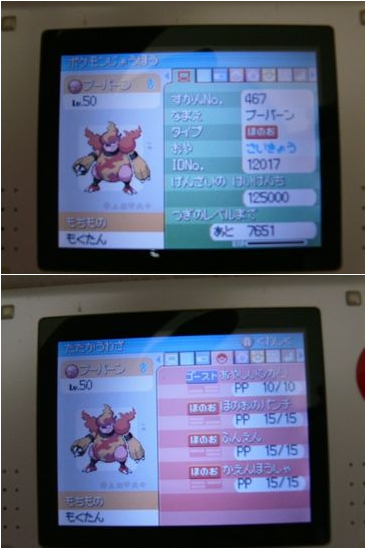
Image credit: sagittarious
So, with that disappointment out of the way, let’s consider the promotional dimension. As mentioned above, CoroCoro reserved a half-page ad for Saikyou Electivire and Magmortar combined. As for Akiyama’s Magmortar showcase on Pokémon Sunday (#164) in a 3v3 Singles Battle against a guest on December 2, 2007… The question is whether this actually concerned a genuine copy of the Saikyou, or whether Akiyaka in fact fielded his own Magmortar posing as one. After it came out as lead, Magmortar battered the enemy Gengar with what looks to have been… Fire Blast. It’s hard to tell, and I compared footage of Battle Revolution to differentiate Flamethrower and Fire Blast. Trouble is, Saikyou Magmortar should not have Fire Blast in its set. Implying, if the above is correct, that Akiyama either modified it, or used an imposter Magmortar. If this Japanese wikia is taken at its word,12It reads: 「ロバートの真剣三番勝負
最強クラスポケモンを得た秋山の、ひさびさ本気ポケモンバトル”」 Akiyama indeed fielded a legitimate Saikyou. But who is to say. I’ll leave it to the reader to choose what to believe.
Whatever the case, it doesn’t appear that the Sunday battle generated a whole lot of additional enthusiasm. That is, if the paucity of Magmortar-themed blogs is anything to go by. Saikyou Magmortar was available December 1-15, 2007, following hot on the heels of E-Vire. However, I found markedly fewer Magmortar blogs than Electivire accounts even though the distribution length, locations and method were identical. Moreover, the modicum of distribution commentary indicated few problems. Blogger “pika-025” quietly received their Magmortar at a PokeCenter without issue, noting how it “was a weekday afternoon, so there were not many people there.” More intriguing were the observations of “fuaa”, who on December 13, 2007 penned blog that echoed “ryublog0718” their Electivire experience, but with a happier resolution:
“Last time at … Electivire, I went to the right place and received a Mystery Gift wirelessly, so I did the same thing [this time], but nothing responded. I thought they were using this [method of wireless distribution] since the store had a DS Station… I was able to access the GTS, so my DS itself was fine… I had no choice but to ask the clerk, who brought out a DS for distribution and told me to use it. The software was running, and I was told that pressing the A button would start distribution, and pressing it again would stop it. I put it in delivery mode and received a Mystery Gift, and it completed easily. I wish they would leave it [the distribution DS] out all the time.”
DIY distribution, imagine that! “Here’s the hardware, kid, you figure it out.” Not in a million years…
Aside from a predictable incredulity about Magmortar’s silly moveset, fans’ feelings were rather neutral towards the Pokémon. Sagittarious at least considered it salvageable, resolving to “raise it carefully” even if they deemed “Magmortar even less cool than Electivire”. On the whole, players like “fuaa” and “sagi” very quickly considered Saikyou Magmortar a done deal as they looked forward to the first of the player-voted Saikyou, crossing their fingers that personal favourites might top the chart, and if they did not, fans at least harboured the sincere hope that whatever would be distributed was more desirable than E-Vire and Magmortar.
By mid-December 2007, the wait was finally over.
Strongest Class Pokémon #3: Milotic
“Milotic was chosen!”, wrote “goantokuinn” jubilantly at 1:40AM (!) local time on December 15th. Clearly, it was worth staying up to share this news.
That day, pokemon.co.jp revealed the first Saikyou chosen for distribution by popular vote. And it’s thanks to French fansite PokeBip which sagely screencapped the updated state of the official page and uploaded it for posterity that we can enjoy a full impression. (No corresponding archival snapshot exists.) In Bip’s image, we can see the site’s fancy Saikyou infographic in all its glory, filled in slot by slot with each Strongest Class votee made public. The accompanying “get to know Milotic” flavour text is also there. Translated, it read:
“Milotic is a Pokémon with few weaknesses and high defense, making it very hard to defeat. Offensively, the damage caused by Hydro Pump under Rain Dance is immeasurable! In addition, Feebas is a difficult Pokémon to collect, and it is moreover necessary to raise its “Beauty” sufficiently to evolve it – a precondition that makes Milotic difficult to obtain.”
Now, in terms of outreach, the comparatively broad news coverage of the event is interesting. GameWatchImpress (here), DengekiOnline (here), and InsideGames all ran articles on Saikyou Milotic where they hadn’t for Magmortar and E-Vire. I’m not exactly sure why, though it could suggest that Milotic was the first – and seemingly only – of the Saikyou for which GameFreak forwarded media outlets an official press release. Sadly their newsposts were devoid of tantalising behind-the-scenes snippets on, say, vote count, paraphrasing as they did the official website and not much else. Most daring was GWI, which – citing factors also mentioned on pokemon.co.jp – ventured to speculate on the reasons why Milotic took a top-3 placement, namely the difficulty of catching Milotic’s pre-evolution, Feebas, and the necessity of raising its Beauty rating to maximum in order to trigger the evolution. Notably, Dengeki reproduced what we may assume was the official website’s Saikyou Milotic portrait posing Looney Tunes-style (see start of this article) which would otherwise have been lost.
Of course, CoroCoro Monthly and Pokémon Sunday did their bits to feed Saikyou Milotic to the fandom. The January 2008 issue of CoroCoro printed a half-page promotion captioned “Grand Announcement of the Pokémon Chosen by Everyone”.13「みんなが選んだポケモン大発表」 It stylishly rearranged visual content also seen on the official website, ie. Milotic’s Looney Tunes portrait and its firing off a Hydro Pump at an unidentifiable enemy. Naturally, the article also sang the praises of Milotic as a powerful Pokémon with few weaknesses that any aspiring hotshot Trainer simply must have in their collection.
As for Sunday, episode #166 (December 16, 2007) marked Shokotan’s turn to wield a Saikyou as she took on a schoolgirl guest in a typical Sunday 3v3 Singles showdown. The superstar led with Charizard but wisely swapped into Milotic when confronted with her opponent’s Blaziken. Milotic wasn’t long for this world, however, for it foolishly took an unfavourable matchup and swiftly fell to a Venusaur. No biggie, though – Milotic got the screentime it needed, sufficient for Sunday to emphasise that Shokotan’s was a very special Saikyou Milotic that you, the viewer, could personally acquire from PokeCenters and select partners.
And – yes, I’m happy to report that Sunday appears to have showcased a genuine Saikyou Milotic and not another stand-in (like for Electivire and Magmortar). Why do I believe this? Well, in episode screenshots courtesy of our friends at pocketmonsters.net, we watch Milotic take a burn from its unusual held item, a Flame Orb (かえんだま), and see Shokotan comment on this unhelpful development.

Clockwise, from top-left: (1) Saikyou Milotic is fielded; (2) Get yours now! (3) Flame Orb hurts Milotic; (4) Shoko-shocked! Stills from: Pokémon Sunday #166, via pocketmonsters.net
Right, so. If we’re looking to establish that Milotic was a popular Saikyou that fans were eager to get their hands on, we needn’t look further than the numerous bloggers who collected it on the first weekend of its availability. Goanntokuinn and Pikachuftt both struck on opening day, December 15 (Saturday); Mew1216 went forth the day after and Daigo4179, Mewsuki, sagittarious all collected on Monday 17th. Elaborate promotional efforts aside, the Pokémon itself offered good reasons to explain this surge in immediate engagement. With – as we shall see – plenty of perks to this particular Saikyou, for once, it was worthy of the epithet “Strongest”. Also, unlike E-Vire and Magmortar, Milotic was not a pseudo-repeat distro, which can only have helped fan engagement. And on the subject of collection, it’s apparent that three distributions into the Saikyou, painful pickup experiences finally took a backseat. That is, the only comments to this discuss logistics at all were by “mew1216” who specified he/she got their Milotic from PC Tokyo, and “goanntokuinn” who mentioned in passing that they got it from the “nearest store”.
Thankfully, this dearth of distribution commentary did not translate to a lack of photographic documentation, for “pika-025”, “pikachuftt” and “goanntokuinn” all took pictures of a Milotic distribution poster. Is anyone else surprised that they were canary yellow in colour rather than marine blue as one might thematically expect?
What did meet expectations, on the other hand, were the characteristics of Saikyou Milotic itself. Far more sensibly designed than either Electivire or Magmortar, Saikyou Milotic had a custom moveset of Rain Dance / Recover / Hydro Pump / Ice Beam, with Hydro Pump not usually learned until Lv.52 (all Saikyou came at Lv.50) and Ice Beam a TM. Its nature was Bold – excellent for a mixed wall – with a hardlocked ability of Marvel Scale. This thing really packed a punch! The only real point of contention in Saikyou Milotic’s otherwise sound design was its held item, a Flame Orb.
Now, we can debate the (de)merits of Flame Orb at length, but the gist is this. While a +50% Flame Orb Defence boost courtesy of Milotic’s ability, Marvel Scale, sounds brilliant in theory, in practice the 12.5% health loss per turn that the Orb inflicts – 18.75% if you factor in the Leftovers Milotic might otherwise have held – is simply too great a drain on its tankiness. Don’t just take my word for it – ask Smogon (e.g. here). Fans questioned it too – wouldn’t Aqua Ring14Which restores 1/16th of a Pokemon’s max HP at the end of every turn. be superior to Recover if a Flame Orb is held, wondered “mewsuki”.
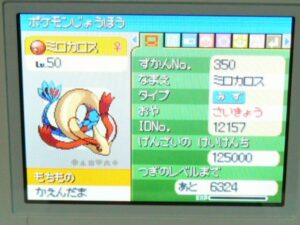
Image credit: yassy0825
Regardless, the consensus seemed to be that Milotic was the first Saikyou properly calibrated to excel in battle. As such, Milotic met with a warm reception, and quite a few bloggers decide to raise it and/or even soft-reset for good IVs. Among them “ryublog0718”, for instance, who spoke of “carefully selecting” a suitable Milotic. And proclaimed “mewsuki”:
“I don’t hate raising it. I think I rather like it. But I’m not good at battles. I wonder if the day will ever come when she [Milotic] will see action.”15「育てるのは嫌いじゃない。むしろ好きかもね♪。でもバトルは苦手^^このコが活躍する日が来るのでしょうか^」
Music to the ears, I’m sure, of the distribution’s intellectual fathers. If mewsuki was at all representative of Pokéfans at large, then the Saikyou were now beginning to stimulate precisely the sort of ordinary-player attitude shift GameFreak hoped for. Competitive battling, yes. That sounds fun!
Strongest Class Pokémon #4: Dragonite
Two is company. Three is a crowd. Four is a full competitive Doubles team. But what might the fourth Saikyou bring?
“Still, what I’m curious about is the distribution starting on [December] 15th. Will Weezing be coming? If it’s a Dragonite or something, I wonder if its level is still 50. I think it evolves at 55.”16「それにしても気になるのは15日からの配布。マタドガスは来るのか?カイリューとかになった場合Lvは50なのかな。進化は55だったと思うけど。」Blogger “sagittarious”, at: http://sagittarious.blog50.fc2.com/blog-entry-401.html
Smart cookie, that “sagittarious”! Not only did he/she anticipate Dragonite’s top-three finish, they also predicted that the poll might spawn a unique Dragonite that cannot exist in normal gameplay. Namely an underlevelled one. But we’ll get to that shortly.
Like the Saikyou before it, Dragonite – or Kairyuu (カイリュー) in Japanese – was officially announced on pokemon.co.jp on the 15th of January. You’ll have to take my word for it, though, for no relevant archival snapshot exists. Even French fansite PokeBip can only help so much here – it preserved the site’s illustration of Dragonite firing off Draco Meteor at an unsuspecting Flygon as well as its giddy Looney Tunes portrait. (Is it me, or does Dragonite appear to wave at the reader?) But the accompanying Dragonite flavour text PokeBip did not save, and sadly appears lost. Direct citations or quotations by media outlets can’t help us either, because there aren’t any. Either the gaming press wasn’t alerted that Saikyou Dragonite’s distribution window had opened, or they chose not to care.
So, CoroCoro. Ah… Unfailing in its promotional duties, as always! Even though this time, the Saikyou advert got demoted from half-page to a smallish inset in an issue whose Pokésection was dominated wholesale by imagery of Mystery Dungeon. In brief, the advert told readers matter-of-factly that Milotic’s distribution had wrapped up and it was now Dragonite’s turn. The underlying conviction was apparently that the Pokémon would sell itself, for a proper rundown of its battle qualities was absent. A friendly wave of the hand (paw?) can do it all.
Pokémon Sunday meanwhile continued its streak of featuring the latest Saikyou in battle. On Sunday #169 (January 13, 2008),17Airing two days before Saikyou Dragonite’s official announcement, you’ll notice that Sunday in fact got the scoop. it was Red Yoshida’s turn to take a Saikyou for a spin. As seems to have been the pattern, his opponent was yet another schoolgirl in a 3v3 Singles Battle. As for the action, well. After opening with Mismagius, Red quickly swapped into Saikyou Dragonite and Dragon Danced up… Before proceeding to annihilate the entire enemy team of Ninetales, Breloom and Swampert with Outrage (げきりん). The poor girl was left visibly shaken. If that wasn’t outstanding PR for the awesome potential of Saikyou Dragonite, I don’t know what is!

Clockwise, from top-left: (1) Dragonite uses Dragon Dance; (2) Ninetales falls to Outrage; (3) Imminent clean sweep; (4) Swampert outgunned. Stills from: Pokémon Sunday #169, via pocketmonsters.net
The clean sweep was somewhat unsurprising, really, given Saikyou Dragonite’s banger of a moveset that transforms Kairyuu into an unstoppable force if you let it set up. This despite the massive contradiction in its design. Can you spot it? I’ll give you a hint. The poll listed Dragonite as the “Strongest” special Dragon-type attacker, its fellow dragon Salamence representing the physical department. And yet, it knew Outrage – a physical move – and Dragon Dance (raises Attack and Speed) even though its Calm nature sacrificed Dragonite’s Attack stat for additional Special Defence. Seriously, were they on crack?
But, players appeared happy to see past this maddening imperfection because of the Pokemon’s other quirk. This was, after all, an ultra-exciting, theoretically impossible Dragonite. In the words of blogger “clipclop“:
“Dragonite does not normally evolve until Lv.55, but it can now be obtained at Lv.50, so one might say that it’s the rarest Pokémon in the Saikyou series.”18「通常ではレベル55にならないと進化しないカイリューを、レベル50で手に入れられるので、さいきょうシリーズの中では一番レアなポケモンと言えるでしょう。」
Well. Considering Dragonite was mass-distributed free of charge all across the Japanese islands, any assessment of its presumed rarity is relative. But this Kairyuu was certainly a freakish new addition to the Pokémon pantheon with some interesting implications. To cite fellow blogger “sagittarious“:
“Noteworthy this time is that it’s Lv.50. Since Dragonair evolves at Lv.55, this is the only distribution where you can get a Lv.50 Kairyuu. This makes it possible to use the Dragonite even in Lv. 50 battles!”19「あと今回の注目すべきところはLvが50ってとこ。カイリューはハクリューがLv55で進化するので、Lv50のカイリューを入手できるのはこの配布だけです。これによってLv50戦でもカイリュー使用可能になりますね!」
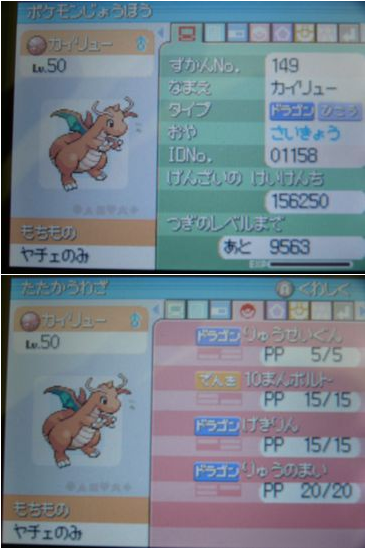
Image credit: sagittarious
Quite right! As we’ve seen in the context of America’s TRU Dragonite, which was a carbon copy of the Saikyou distribution localised for US audiences, this Dragonite was eligible for all official Pokémon tournaments which, as a rule, capped entrants at Lv.50. In other words, whereas Dragonite had until then been excluded from competition, this Saikyou ended Kairyuu’s sidelining with immediate effect. In terms of moveset, Outrage and Dragon Dance – not normally learned by Dragonite until Lv.53 and Lv.64 – were nice touches if not for the caveat above.20In this context, it’s worth mentioning that Outrage is not an egg move in Generation Sinnoh, while the move tutor that can teach it was not introduced until Platinum. In other words, for the next nine months until the Japanese release of Platinum in September 2008, Saikyou Dragonite was the only one of its kind that could run Outrage <Lv.50. The inclusion of Thunderbolt saved players a precious non-reusable TM. And by way of added bonus, Dragonite held a rare Yache Berry, which halves the power of super-effective Ice moves against it that are arguably the Pokémon’s Achilles’ heel.
Even those who cared neither about the competitive aspect nor the Pokémon’s underlevelled character were still thrilled by Dragonite’s success in the poll. “Sagittarious” promised to raise the Dragonite despite its obvious drawbacks. Blogger “nao-jun” (here) quite simply wrote: “I love Dragonite, so I’m happy!” Or take “mochamochado”, who noted in a state of pure bliss:
“The [latest] ‘Strongest Pokémon Gift Project’ … was Dragonite. It’s a good choice, isn’t it? I was wondering why I didn’t have a Kairyuu before. So, of course I grabbed it! I’m so happy!”
Finally, PokeCenters offered one more Saikyou-themed incentive to deepen the joy.21You’ll notice that the usual “show and tell” for Dragonite’s distribution poster is absent. The reason is that, against all odds, there’s no quality image of it floating about on the web. A massively grainy collage by “pika-025” on their blog comes closest, here: https://blog.goo.ne.jp/pika-025/e/2450f864f8d15b9e21d2e8ceaf6839d2 Players who showed PC staff a Saikyou Milotic on their D&P game while roaming the store to collect Dragonite were eligible for a surprise goodie: a decorative Milotic sticker! Cute!
“Yassy0825” got theirs at PC Osaka (here). “Pika-025” obtained one too, and we’ll close out this Saikyou Dragonite section with a joyous excerpt from their blog (here) that spread happiness and promised additional goodies once that mysterious fifth and final “Strongest Pokémon” was at long last announced:
“On the distribution’s first day, the 15th [of January], I immediately went to get a Dragonite! Pokémon Centers are delivering Kairyuu and giving away stickers. To get a sticker, you need to show the DS screen of the previous “Strongest” Milotic. The staff will give you a sticker after confirming it. By the way, if you receive all of the 3rd, 4th, and 5th of the “Strongest” series, I heard that you can get a PokeCenter original glitter card.”22「配信初日の15日、さっそくカイリューを貰いに行ってきました。ポケモンセンターではカイリューの配信とシールのプレゼントをしています。シールを貰うには前回の「最強ミロカロス」のDS画面をスタッフに見せると確認後シールをくれます。ちなみに最強シリーズ3~5弾を全部受け取るとポケセンオリジナルキラカードが貰えるらしいですよ~」
Very promising! But was it true?
All in all, Dragonite pushed the Saikyou Saga to a new high. Could the final Pokémon gloriously capstone it, thus closing out Sinnoh’s largest-ever distribution with a bang? Let’s find out.
Strongest Class Pokémon #5: Salamence
Number five. Fifth and final. The last opportunity for a personal favourite to be distributed. With bated breath, fans waited:
“Well, only one more to go! What will the last Pokémon be? The lineup has been great so far, but there won’t be a big surprise at the end, will there? I’m looking forward to it.”23Words of “mochamochado”, at: https://blog.goo.ne.jp/mochamochado/e/f886086546b129042973edc53ce2042d
On February 10, 2008, variety show Pokémon Sunday broke the silence. Or, well, I *think* it did.
After Akiyama, then Baba, Shokoton and Prof. Red, it was now Chief Golgo’s turn to wield a Saikyou. On episode #173 (February 10, 2008) in a typical Sunday 3v3 Singles Battle versus yet another primary schooler, the famous Rika (see below), Golgo led with Raichu, then brought out his legendary miracle-worker Focus Band Octillery, and then stunned the audience by fielding a shock Salamence.
Now, I don’t know for certain that Sunday communicated to viewers that this particular dragon was a specimen of the fifth and final Saikyou. The evidence from the show available to me is inconclusive. But even if Sunday purposely kept mum until pokemon.co.jp.and CoroCoro could formally broadcast the news, it would be an insult to fans’ intelligence to assume that, after a pattern of four Saikyou all showcased on Sunday around their release date, they now failed to recognise Salamence for what it was. And so, word was on the street. Incidentally, Rika’s team of Walrein, Flygon, and a third Pokémon that never came off the bench absolutely trashed Golgo, and this fateful defeat forever cost him his beloved Miracle Octillery “Octaan” immortalised in October 2007’s “Golgo Octillery” distribution. (It was tearfully traded over to Rika – to the victor go the spoils!)
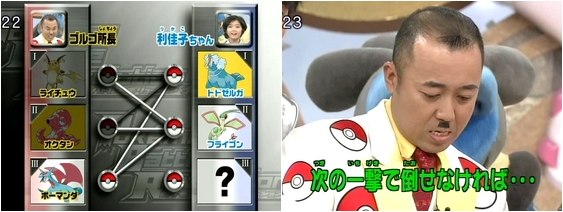
“Salamence’s attack will put everything right”. Stills from: Pokémon Sunday #173, via pocketmonsters.net
The official pokemon.co.jp website, too, made the final reveal a little early this time, most likely on February 11, 2008 with Salamence’s distribution to start the 15th. A stripped-down archival snapshot of the website reveals the Salamence flavour text, but we needn’t bother with it, for PokeBip had the extraordinary foresight to take a full live image of the page. The text read, translated:
“Salamence can lower the opponent’s attack with its ability “Intimidate”, making it difficult to defeat with physical moves. Conversely, it can inflict heavy damage with powerful moves such as Dragon Claw, which matches its [Dragon] typing. Since the Pokémon can use not only physical attacks but also special attacks, it can be trained to learn a variety of moves according to the Trainer’s preferences! However, Salamence is vulnerable to the Ice-type attacks, so be careful not to get hit by them.”
Sounds great, doesn’t it? Weeeell. We’ll get to that, after we make our obligatory stop by CoroCoro. Somewhat pathetically, Saikyou Salamence was allocated even less space in the mag than Dragonite, having to make do with a tightly compressed notice that it could now be collected from participating stores. And ah, yes, Salamence can use Dragon Claw. Uh-huh. Very important.
In terms of popularity, you’re forgiven for assuming that Salamence’s announcement was met with cheers and hurrahs. As much as I hate to report it, the contrary is true. Take the much-quoted “sagittarious” for example, who admitted: “To be honest, I don’t like it. I don’t particularly want it, but I’ve gotten past Saikyous, so I decided to get it again this time.” On some level, it was perhaps inevitable that players would feel let down by whatever Pokémon out of the remaining 30 (!) took the final spot. That said, there was some genuine substance to the disappointment over Salamence. “The Saikyou series has become a series of dragons”, joked “pika-025”.24「最強シリーズは連続ドラゴンになってしまいましたね^^;」
Analytically speaking, there were two reasons for what (looks like) mild frustration over Salamence’s (s)election. First was the ease of obtaining one in regular gameplay, which made Salamence feel like a wasted slot. Wrote “g3naorin”:
“Why vote for such an easy-to-get guy?” […] Salamence can be obtained normally, and evolution is easy. […] It is true that Milotic is difficult to evolve and Dragonite was a rare species at Lv.50. But this Salamence… What on earth were the people who voted for this thinking?”25「何故にこんなゲットのしやすい奴に投票するんじゃ?[…] ボーマンダなんて普通にゲット出来るし進化だって簡単に。確かにミロカロスなら進化はさせにくいし、カイリューはLV50という希少種でした。しかしこのボーマンダは…。」
Blogger “sagittarious” agreed:
“I can’t believe the last one was Salamence… I don’t really like this Pokémon. I think you could tell from the low tension. I would have preferred PorygonZ or Rhyperior whose evolution items are precious. Or maybe a Lv.55 fully-evolved Tyranitar. Weezing [his personal favourite, ed.] was no good after all. […] The result of the vote was Milotic, Dragonite, and Salamence. Dragon popularity. Milotic’s egg group is also Dragon…”26「それにしても最後がボーマンダとは・・・。このポケモンあんまり好きじゃないんよ。テンションの低さから伝わったと思うけど。進化アイテムが貴重なポリゴンZかドサイドンとかが良かった。それか55レベル進化のバンギラスとか。マタドガスは結局駄目だったのね。[…] 投票結果はミロカロス、カイリュー、ボーマンダっていうことで。ドラゴン人気ですね。ミロカロスも卵グループがドラゴンだし。」
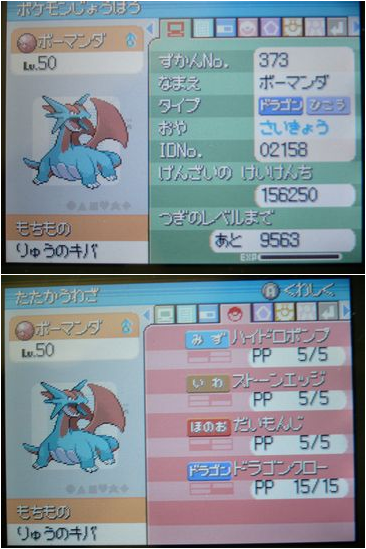
Saikyou Salamence. Image credit: sagittarious
Second – and this is ironic – the growing crop of discriminating, battlewise Pokéfans that the Saikyou series sought to cultivate was unimpressed by the lack of refinement in Salamence’s design. If the “Strongest” campaign had succeeded in raising the standards of player engagement with and understanding of competitive battling, this was now being used against it. GameFreak must’ve been so proud.
To be sure, Saikyou Salamence harboured few surprises. (Although perhaps, viewed through the prism of Milotic’s Flame Orb and Dragonite’s nature-moveset mismatch, this was for the better.) Its moveset of Hydro Pump / Stone Edge / Fire Blast / Dragon Claw paired with a Naughty nature made for a competent mixed sweeper. Never mind that the poll had presented Salamence as a physical attacker. At least it had Fire Blast, a TM that Magmortar was denied. Altogether the Salamence was workable, but that didn’t stop fans from shining a critical light:
“The moves it knows can be easily learned through heredity! […] It’s perfectly normal. Had Dragon Claw at least been Dragon Rush, it would have been different. And since Salamence doesn’t know Dragon Dance, that means it’s totally a mixed attacker specification.”
Thus wrote “g3naorin”. And again, “sagittarious”:
“Mixed attacker, after all. Stone Edge and Dragon Claw are physical techniques. But Dragon Claw is not powerful enough… And since Salamence is a Dragon / Flying type, it would have been nice if they had included something like Aerial Ace. The Hydro Pump is as expected. I didn’t know they could learn Hydro Pump. I’m not interested in Bomanders, so I don’t have any knowledge about them.”
Salamence, then, invited plenty of discussion. Which for all its imperfections was perhaps exactly what GameFreak hoped to encourage.
Right! Let’s switch gears. Remember that freebie Milotic sticker? It was back. In force! Parallel to Salamence’s distribution, PokeCenters around Japan gave out stickers for both Dragonite and Salamence. They could be collected in one go if fans showed PC staff their last two Saikyou. As did yassy0825, for example, at PC Osaka (here).
True fans who could prove they hadn’t skipped any of Strongest Milotic, Dragonite or Salamence were eligible for an additional, ultra-cool present… You guessed it, the “glitter card” that pika-025 had caught wind of weeks before. Featuring all three Saikyou in an entwined, lunging pose, it was simply gorgeous, one of the most beautiful Pokémon artworks I’ve seen. Boy do I want one. Players could grab themselves three copies through March 31, 2008.
And with that, after four exciting months, the Saikyou campaign came to an end. Or… Did it?
“Strongest Pokémon Battle Dream Match”
I’m going to keep this brief, mostly because little is known about this all-star showdown. But it’s definitely worth a mention and, hopefully one day, we’ll be able to piece together more.
Came March 2008, GameFreak wasn’t in fact done promoting the battle revolution that the Saikyou Campaign had unleashed. Sometime that month, the pokemon.co.jp official event page was updated to say the following:
“D&P Strongest Pokémon Battle Dream Match” now open on Pokémon Daisuki Club! The staff of Game Freak Inc., the developer of ‘Diamond & Pearl’, has come up with a recommended team composition that will showcase the strength of the ‘Strongest Class Pokémon” selected by votes from everyone! In addition, selected members of the Daisuki Club have challenged the team to a battle! Check out the video of this hot battle! It is now available on the official fan club ‘Pokemon Daisuki Club’ (no registration or annual fee)!27「ポケモンだいすきクラブで「DP最強ポケモンバトル ドリームマッチ」公開中!みんなからの投票で選ばれた「最強クラスのポケモン」の強さが発揮できるおすすめのチーム構成を、「ダイヤモンド・パール」を開発した株式会社ゲームフリークのスタッフが考えてくれたよ!さらに、だいすきクラブの選抜メンバーがこのチームにバトルをいどんだぞ!このアツいバトルの様子を動画でチェックしよう!公式ファンクラブ「ポケモンだいすきクラブ」(登録・年会費無料)で公開中だよ!」
Daisuki Club, we meet again! Obviously, the Daisuki Club video was locked behind a registration wall and is therefore long gone. Did it feature Nana, RuiRui, Uttsu or any other well-known Daisuki members, I wonder? (See also Valentine Magikarp.) The referenced materials provided by GameFreak are also lost. Hopefully these will surface one day. One thing, however, is abundantly clear. GameFreak was determined to introduce as many players as possible to the world of competitive battling, for very soon, top-level tournaments would kick into high gear, culminating in the first World Championships held that Summer of 2008. The world had best be ready.
To conclude this article, I will leave you with a forward-looking teaser. That is, a mysterious snippet from the Sala-collection account of blogger “mewsuki” (here):
“February 27, 2008. Pokémon were distributed exclusively at PokeCenter Tokyo. Not much is known about it, apparently. Next to the “Saikyou Salamence Distribution” flyer presented at PokeCenter Tokyo, there is a small notice. […] I received the strongest Salamence. I also received a sticker of the strongest Dragonite. I bought some Sleeping Pikachu cookies and other goodies. I wandered around Ikebukuro and returned home. I checked the eggs. Their parents’ name was TOKYO.”28「そして2008年2月27日ポケセン東京限定でポケモンが配布された。あまり知られていないらしいポケセン東京に提示されている「さいきょうボーマンダ配布」のチラシの横にちいさくお知らせがある […] 最強ボーマンダをいただき、最強カイリューのシールもいただき、おねむりピカのクッキー&グッズを少々買い池袋をさまよい歩き帰って来ました^^卵を調べてみると「親名・TOKYO」でした」
TOKYO eggs and a Sleeping Pikachu? How intriguing! Read about it here!
- Harvest Moon 3 (2001) - March 5, 2020
- Pokémon Trading Card Game 2 (2001) - February 5, 2020
- Yu-Gi-Oh! Dark Duel Stories (2002) - January 5, 2020

